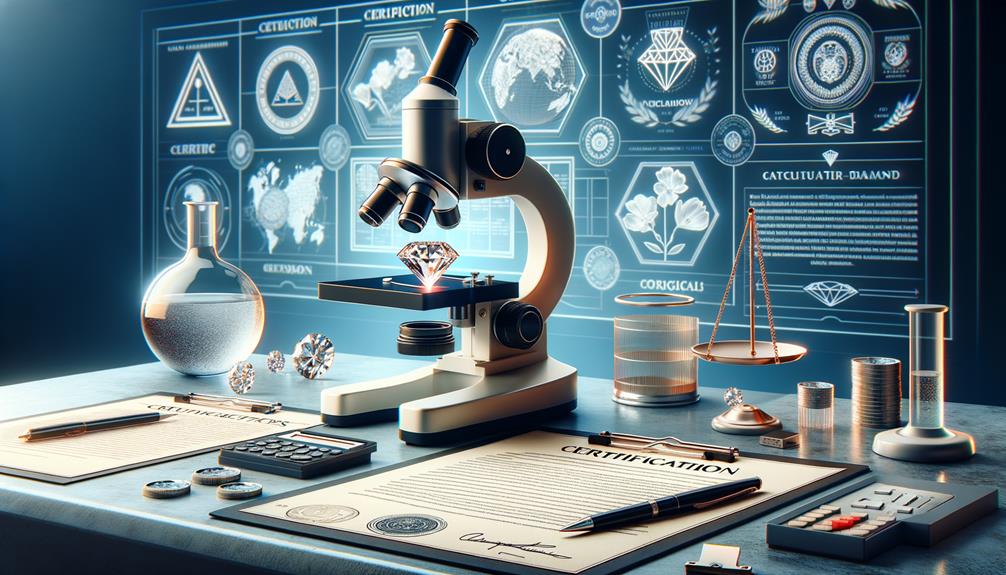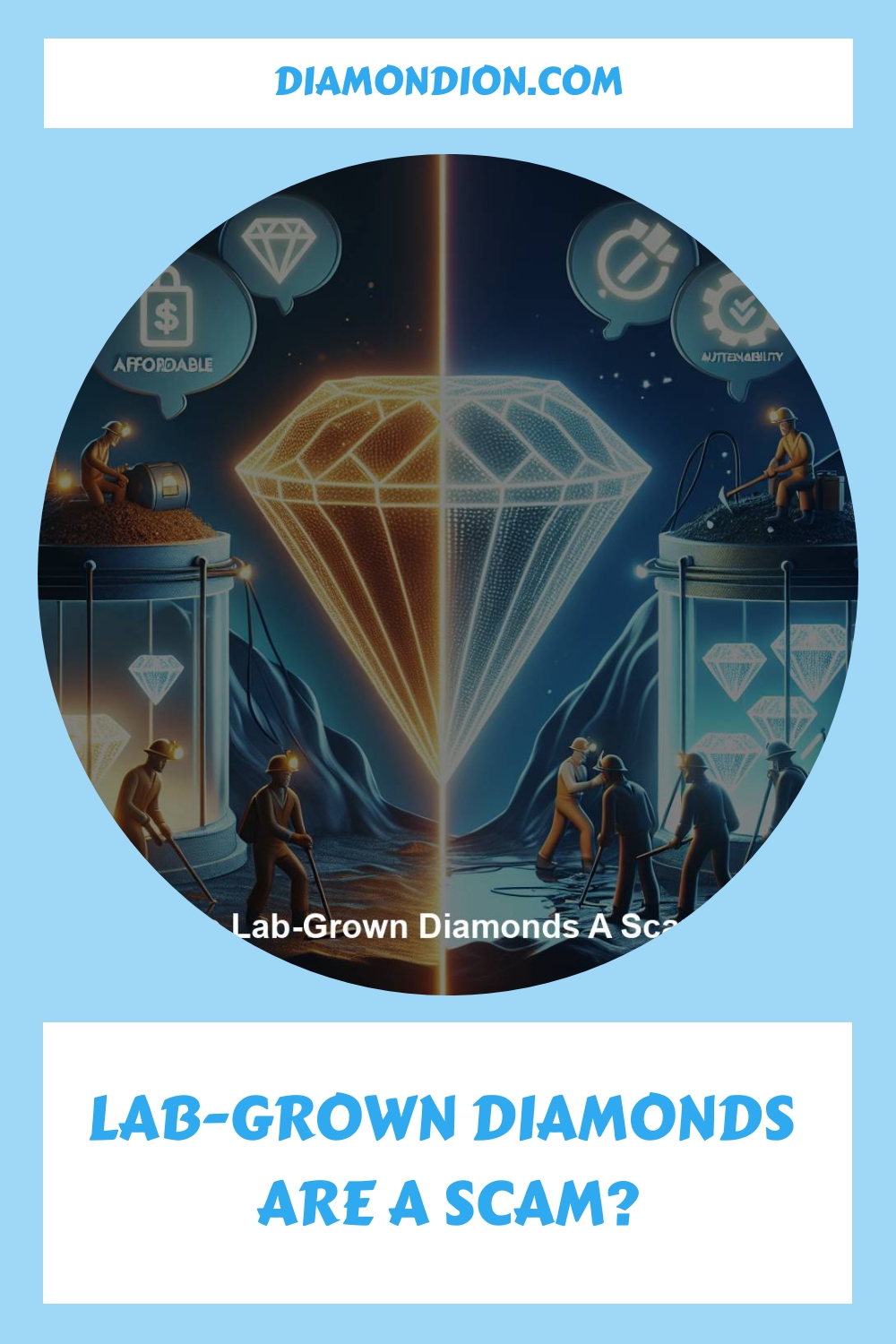Article Contents
- 1 Key Takeaways: Whether Lab-Grown Diamonds Are a Scam
- 2 Historical Development
- 3 Scientific Identification
- 4 Price Discrepancies
- 5 Resale Value Realities
- 6 Consumer Perspectives On Lab-grown Diamonds
- 7 The Environmental Impact of Lab-grown Diamonds
- 8 Regulatory Standards For Lab-Grown Diamonds
- 9 Industry Challenges Facing Lab-grown Diamonds
- 10 Frequently Asked Questions
- 11 Our Take On The Lab Vs. Natural Controversy
- 12 Are Lab-Grown Diamonds Truly a Scam or a Sustainable Alternative?
- 13 Further Reading About This Topic
The advent of lab-grown diamonds has introduced a paradigm shift in the gemstone industry, presenting both a challenge and an opportunity to the norms of diamond valuation and acquisition. As scientific advancements have made the creation of these stones more accessible, the market has witnessed a growing influx of synthetically produced diamonds that rival their natural counterparts in appearance and chemical structure.
This development has sparked a contentious discussion among consumers and professionals alike regarding the authenticity and value of lab-grown diamonds. While advocates argue in favour of their ethical and environmental advantages, sceptics question whether these man-made gems carry the same intrinsic value and legacy as those mined from the earth.
As we examine the intricate layers of this debate, one must consider the implications for the broader gemstone market, the rigorous testing methods employed to distinguish lab-grown from natural diamonds, and what this means for the future of luxury goods.
The answer to whether lab-grown diamonds are a scam, a misleading ploy, or a legitimate alternative lies at the intersection of science, ethics, and economics—a nexus that we shall navigate to uncover the facets of truth in this glittering controversy.
Key Takeaways: Whether Lab-Grown Diamonds Are a Scam
- Lab-grown diamonds have a historical development dating back to the late 18th century and were initially created for industrial applications.
- Advanced scientific identification methods, such as spectroscopy and isotopic analysis, can detect unique characteristics of lab-grown diamonds, ensuring transparency in the purchasing process.
- Lab-grown diamonds often have a higher retail markup despite their lower production costs, and they tend to depreciate more quickly and have less resale value compared to natural diamonds.
- Consumer perspectives on lab-grown diamonds vary, with younger consumers valuing the ethical and cost-saving benefits. At the same time, some still perceive natural diamonds as the “real thing” for significant life events.
Historical Development
The historical development of lab-grown diamonds, often referred to as synthetic or cultured diamonds, can be traced back to pioneering research and experimentation in the late 18th century, laying the foundation for today’s advanced diamond synthesis technologies. Initially, the creation of synthetic diamonds was not intended for the jewellery market but rather for industrial applications, where the properties of diamonds were sought without the need for natural gemstone aesthetics.
In the arena of the diamond industry, the quest to manufacture diamonds artificially took a significant turn in 1954 when a reproducible method was developed. Then, General Electric (GE) revealed its ability to synthesize diamonds using high-pressure, high-temperature (HPHT) techniques. This breakthrough mirrored a claim made a year earlier, in 1953, by ASEA. This Swedish utility company was purported to have developed a process for creating diamonds in a lab setting.
These lab-grown diamonds, which share the same chemical and physical properties as natural diamonds, began challenging traditional perceptions within the diamond industry. The distinction between natural diamonds and their lab-created counterparts has become a focal point of debate, with authenticity and representation at the core. For individuals seeking to belong to a natural diamond ownership tradition, understanding synthetic diamonds’ origin and development is crucial for informed decision-making.
Scientific Identification
Scientific advances in diamond identification, such as spectroscopy and isotopic analysis, have become pivotal in accurately distinguishing lab-grown diamonds from their natural counterparts. The Gemological Institute of America (GIA), a leading authority in diamond grading, employs these techniques to ensure the authenticity of diamonds and protect consumers.
- FTIR spectroscopy and other advanced spectroscopy techniques can find the unique features of lab-grown diamonds, usually showing the presence of nitrogen-vacancy centers that are typical of the Chemical Vapor Deposition (CVD) process.
- Isotopic analysis: determines the carbon isotopic ratio, which can be distinct between lab-grown and natural diamonds.
- Diamond grading certificates, issued by organizations like GIA, provide a detailed report on the diamond’s properties, ensuring transparency and confidence in purchasing.
- Growth pattern examination: Lab-grown diamonds may display growth patterns and inclusions that differ from those found in natural diamonds, serving as identifying markers.
The scientific identification of lab-grown diamonds is a testament to the precision and reliability of modern gemology. It assures individuals of their belonging to a community where integrity in acquisition is valued and informed decisions are the norm.
The unambiguous differentiation between lab-grown and natural diamonds fortifies consumer trust and maintains industry standards.
Price Discrepancies
Understanding the price discrepancies between lab-grown and natural diamonds is essential, as lab-created stones often command a higher markup despite their lower production costs. The market value of lab-grown diamonds can be a complex topic. While they may appear more affordable initially, the higher retail markup challenges this perception. Because lab-grown diamonds are created in a controlled environment, they don’t carry the same scarcity as natural stones, which can contribute to the latter’s higher price.
Natural diamonds have traditionally held their value over time, bolstered by a well-established and regulated resale market. On the other hand, lab-grown diamonds tend not to retain their value as well, primarily due to the lack of liquidity and absence in secondary markets. This lack of resale value can contribute to the price discrepancies seen between lab-grown and natural stones.
Furthermore, some jewellers may capitalise on the burgeoning interest in lab-grown diamonds to achieve higher profit margins, which could mislead consumers about the actual value of these stones. For individuals seeking the long-term investment aspect of diamond ownership, the uncertainty surrounding the value retention of lab-grown diamonds is a significant factor to consider.
Resale Value Realities
Despite their initial lower cost, lab-grown diamonds often face challenges in retaining value as they do not possess an established resale market comparable to that of natural diamonds. The realities of resale value for lab-created stones can surprise many who see them as a cost-effective alternative to real diamonds. This can influence the perception of their natural value, especially for those seeking diamonds for their beauty and as a potential investment.
Here are some critical points to consider regarding the resale value realities:
- Lab-created diamonds typically depreciate more quickly than natural diamonds.
- The rarity and historical increase in value associated with natural diamonds do not apply to lab-grown equivalents.
- A significant factor influencing resale value is consumer perception, which still leans in favour of real diamonds.
- Technological advancements may lead to cheaper production methods for lab-created diamonds, potentially further diminishing their resale value.
Understanding these resale value realities is crucial for consumers who are looking for more than just the immediate gratification of a diamond purchase but also considering the long-term implications of their investment.
Consumer Perspectives On Lab-grown Diamonds
While the resale value challenges of lab-grown diamonds are significant, consumer perspectives on these stones also play a pivotal role in shaping their market position and acceptance. The Federal Trade Commission (FTC) mandates clear labelling of lab-grown diamonds to prevent any misleading claims, addressing consumer concerns about authenticity. However, the scepticism surrounding their long-term value continues to influence buying decisions.
The liquidity and perceived value of lab-grown diamonds as compared to natural stones frequently influence consumer attitudes. There is also an emotional component at play; a portion of the market continues to see natural diamonds as the ‘real thing’ when it comes to significant life events like engagements and weddings. Nevertheless, younger consumers are increasingly open to lab-grown options, valuing the ethical and cost-saving benefits.
Here is a summary of key consumer perspectives:
| Aspect | Lab-Grown Diamonds | Natural Diamonds |
|---|---|---|
| Initial Cost | Generally lower | Higher |
| Resale Value | Questionable, less liquid | Established, more liquid |
| Perception as ‘Real’ | Often seen as less ‘real’ | Traditionally, the ‘real thing’ |
An analytical view suggests that while acceptance is growing, concerns about value and tradition still weigh heavily on consumer choices.
The Environmental Impact of Lab-grown Diamonds
Examining the environmental implications of lab-grown diamonds reveals a complex picture where the sustainability of these gems hinges significantly on the energy sources utilized during their production. The lab-grown industry promotes its products as a cleaner alternative, yet the environmental impact varies widely based on several factors:
- The type of energy source used: Renewable energy leads to a lower carbon footprint compared to fossil fuels.
- The efficiency of the production process: Technological advancements can reduce energy consumption.
- The origin of the carbon source: While some methods use natural gas, others may employ less impactful sources.
- The lifecycle analysis of the product: This includes considerations from production to disposal.
Producing lab-grown diamonds involves high-temperature and high-pressure processes that are energy-intensive by nature. If the energy used is derived from carbon-heavy sources such as coal, the environmental advantage diminishes. Conversely, if producers harness renewable energy, the carbon emissions associated with lab-grown diamonds can be significantly reduced.
Thus, consumers seeking to align with eco-conscious values must critically assess the practices of the lab-grown industry, considering both the potential benefits and the environmental impact of their choices.
Regulatory Standards For Lab-Grown Diamonds

In the context of the environmental considerations surrounding lab-grown diamonds, it is also critical to address the regulatory standards that govern their marketing and sale. The Federal Trade Commission (FTC) has established guidelines to ensure that lab-grown stones are marketed with transparency. Such standards are pivotal in maintaining consumer trust and supporting an informed public.
The FTC explicitly prohibits the use of terms like ‘real,’ ‘genuine,’ or ‘natural’ to describe lab-grown diamonds without clear modifiers that indicate their origin. This is to prevent any attempts by sellers to pass off lab-grown stones as mined diamonds, thereby ensuring that consumers are not misled.
Furthermore, the regulatory standards require that lab-grown diamonds be labelled with terms such as ‘lab-grown’ or’ manufactured’ to provide clear differentiation from their natural counterparts. Organizations like the Natural Diamond Council and industry leaders such as Jean-Marc Lieberherr advocate for these strict labelling practices to uphold the integrity of the natural and lab-grown diamond markets.
Adhering to these regulatory standards is essential for fostering a sense of belonging among consumers who value both ethical practices and clarity in their purchases.
Industry Challenges Facing Lab-grown Diamonds
Navigating the complexities of the diamond industry, consumers and retailers alike encounter significant challenges when it comes to lab-grown diamonds, such as misleading labels and the uncertainty of resale value. Lab-grown options have led to a seismic shift in the diamond landscape, sparking debate and scrutiny over how these stones are presented and valued within the market.
To better understand the industry’s hurdles, consider the following points:
- Misleading Marketing: Some lab diamonds are presented with ambiguous terminology, obscuring the fact that they are not mined from the earth, which can mislead consumers seeking natural diamonds.
- Resale Value: Lab-grown diamonds typically have a lower resale value compared to their natural counterparts, affecting the long-term investment aspect for buyers.
- Identification Challenges: Jewelers must implement rigorous protocols to prevent the accidental mixing of lab and natural diamonds, a mix-up that could erode trust among consumers.
- Market Liquidity: The absence of a standardized resale market for lab-grown diamonds hinders their liquidity, presenting a challenge for owners looking to sell.
In an industry where trust is paramount, transparency around the origin, value, and classification of diamonds—whether lab-created or natural—is crucial. Stakeholders must navigate these challenges to maintain integrity and ensure that authenticity and clear communication meet the desire for belonging within the diamond community.
Frequently Asked Questions
Are Lab-Grown Diamonds Considered Fake?
Lab-grown diamonds are chemically identical to natural ones. They are not considered fake, but transparency in labelling is crucial to accurately inform consumers about the nature and origin of their diamond purchases.
Are Lab-Grown Diamonds a Waste of Money?
Lab-grown diamonds offer value for those prioritizing cost and ethical considerations. While resale prices may be lower than those of natural diamonds, they are not a waste of money if they align with a buyer’s preferences and values.
Is It Wise to Buy Lab-Grown Diamonds?
Lab-grown diamonds pose a complex question for buyers seeking long-term value. Though they offer initial affordability, their investment potential remains uncertain, necessitating thorough research and consideration of personal values and future market trends.
Is It Tacky to Get a Lab-Grown Diamond?
Choosing a lab-grown diamond is a personal preference and not inherently tacky. It reflects a modern choice that balances cost, ethical considerations, and environmental concerns, aligning with values important to many contemporary consumers.
Our Take On The Lab Vs. Natural Controversy
Lab-grown diamonds have ignited a supernova of controversy within the jewellery cosmos. While not a scam when accurately represented, they present a labyrinthine challenge in ensuring consumer enlightenment and industry integrity. In the ned, though, it is up to you to make up your own mind as to whether lab-grown diamonds are a scam.
Vigilant regulatory frameworks and scrupulous disclosure practices are paramount to navigating this evolving starscape. As the debate rages like a tempest, informed consumer choice remains the bedrock upon which the edifice of this market’s future will stand or crumble.
Are Lab-Grown Diamonds Truly a Scam or a Sustainable Alternative?
The debate around labgrown diamonds continues to spark interest. Unlike mined stones, these gems are created in controlled environments, offering a sustainable option with minimal environmental damage. Critics question their authenticity, yet their physical and chemical compositions mirror mined diamonds, making them a compelling choice for ethical and eco-conscious consumers. Supporters argue that investing in sustainable diamond production is essential for reducing the harmful impact of traditional mining practices on the environment and local communities. With advancements in technology, lab-grown diamonds also offer a more transparent supply chain, ensuring that the entire process is free from human rights abuses and environmental destruction. Ultimately, the growing interest in lab-grown diamonds reflects a shift towards responsible and sustainable choices in the jewelry industry. Additionally, many consumers are drawn to the idea of supporting sustainable diamond production as a way to promote positive social and economic impact in diamond-producing regions. By opting for lab-grown diamonds, individuals can contribute to the development of responsible and fair practices within the industry, ultimately leading to a more equitable and environmentally friendly marketplace. As the demand for sustainable diamond production continues to rise, it is likely that more advancements and innovations will further solidify the place of lab-grown diamonds in the market.
Further Reading About This Topic
- Understanding The Legal And Regulatory Framework Of Synthetic Diamonds: https://www.diamondregistry.com/news/understanding-the-legal-and-regulatory-framework-of-synthetic-diamonds/
- How synthetic diamonds are upending the industry’s status quo: https://theweek.com/business/synthetic-diamond-industry-lab-grown-value
- The Environmental Impact of Lab-Grown Diamonds: https://earth911.com/style/the-environmental-impact-of-lab-grown-diamonds/
- Consumers View Natural, Lab-Grown Diamonds Differently, Says De Beers: https://www.jckonline.com/editorial-article/consumers-natural-lab-growns/
- Why Lab-Grown Diamonds Are Not A Smart Investment: https://www.samuelsonsdiamonds.com/insights/lab-grown-vs-natural-diamonds-resale-value-breakdown/
- A Brief History of Lab-Grown Diamonds: https://www.gemsociety.org/article/brief-history-of-lab-grown-diamonds/



